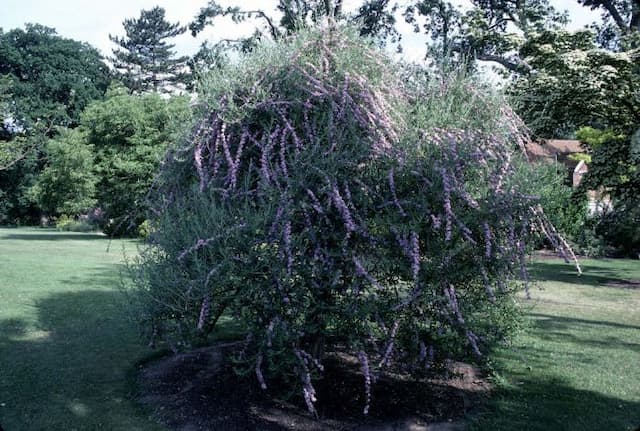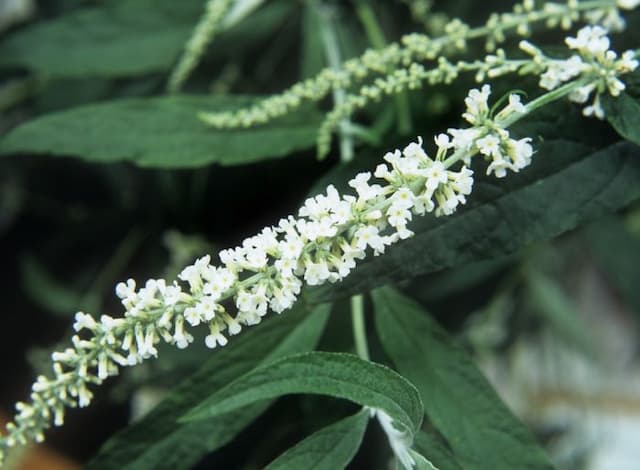Mullein 'Norfolk Dawn' Verbascum 'Norfolk Dawn'

ABOUT
'Norfolk Dawn' grows to 1.5m tall, with large basal leaves and buff-yellow flowers 2.5cm across opening in flushes over a long period in summer
About this plant
 Names
NamesFamily
Scrophulariaceae
Synonyms
Mullein, Velvet Plant
Common names
Verbascum 'Norfolk Dawn'
 Characteristics
CharacteristicsLife cycle
Biennials
Foliage type
Semi-deciduous
Color of leaves
Green
Flower color
Pink
Height
2 feet 6 inches (0.76 meters)
Spread
1 foot 8 inches (0.51 meters)
Plant type
Herb
Hardiness zones
5
Native area
Europe
Benefits
 General Benefits
General Benefits- Attracts pollinators: Verbascum 'Norfolk Dawn' is great for attracting bees and other beneficial insects to your garden.
- Drought-tolerant: Once established, it has low water requirements, making it ideal for xeriscaping or drought-prone areas.
- Easy to grow: It is generally low-maintenance and easy to cultivate in well-draining soil with full sun exposure.
- Long blooming period: The plant has a long flowering period, providing color and interest in the garden for an extended time.
- Cottage garden appeal: With its tall spires of flowers, it adds a traditional and naturalistic charm to cottage-style gardens.
- Architectural interest: The vertical lines of its flower spikes can be used to create structure and height in garden design.
- Deer resistant: It is not favored by deer, making it suitable for gardens in areas with high deer populations.
 Medical Properties
Medical PropertiesThis plant is not used for medical purposes.
 Air-purifying Qualities
Air-purifying QualitiesThis plant is not specifically known for air purifying qualities.
 Other Uses
Other Uses- Mullein 'Norfolk Dawn' can be used as a natural dye, offering a range of colors from yellow to green depending on the mordant used.
- The thick, soft leaves of the Mullein 'Norfolk Dawn' can serve as an improvised insulation material, due to their felt-like texture.
- Dried Mullein 'Norfolk Dawn' stalks are sometimes used in handicrafts for making rustic-looking floral arrangements.
- The plant can act as a natural fish poison; historic practices involved using Mullein to stun fish, making them easier to catch.
- The leaves of Mullein 'Norfolk Dawn' can be used to create a natural flame retardant extract, which can be applied to materials as a fire suppressant.
- The fuzz on Mullein 'Norfolk Dawn' leaves can be used for tinder when starting fires in survival situations, as it catches fire easily.
- Because of its height and structure, Mullein 'Norfolk Dawn' might be used in garden design to create vertical accents in a flower bed.
- The Mullein 'Norfolk Dawn' can be incorporated into permaculture systems as a trap plant for insects, serving as a decoy to protect other plants.
- The spent flower stalks of Mullein 'Norfolk Dawn' can be transformed into small natural tools such as stakes for supporting other plants in the garden.
- The seeds of Mullein 'Norfolk Dawn' contain saponins and could be used as a natural fish lure or bait due to their potential toxicity to aquatic life.
Interesting Facts
 Feng Shui
Feng ShuiThe Mullein is not used in Feng Shui practice.
 Zodiac Sign Compitability
Zodiac Sign CompitabilityThe Mullein is not used in astrology practice.
 Plant Symbolism
Plant Symbolism- Healing: Verbascum, commonly known as Mullein, has been used in traditional medicine for treating respiratory ailments, symbolizing physical and emotional healing.
- Protection: Mullein is believed to ward off evil spirits and bad luck, offering spiritual and psychic protection to those who carry it or plant it around their home.
- Courage: The plant's sturdy stalk can symbolize standing tall against adversity, thus representing courage and resilience.
- Love: In some folklore, Mullein is associated with love divination, indicating that its presence may attract or signify true love.
 Water
WaterThe Mullein 'Norfolk Dawn' prefers a moderate watering schedule, generally requiring watering once a week, depending on the weather and soil conditions. Provide enough water to moisten the soil to a depth of about an inch. It's important not to overwater, as the plant is drought-tolerant and excess moisture can lead to root rot. During the hotter, drier months, you may need to increase the frequency to keep the soil from drying out completely. Always check the top inch of soil for dryness before watering; if it is dry to the touch, it's time to water, using about one gallon of water per plant.
 Light
LightThe Mullein 'Norfolk Dawn' thrives in full sunlight. It requires at least 6 hours of direct sun each day, so planting it in a spot that receives ample sunlight throughout the day is ideal. Avoid shaded areas, as insufficient sunlight can lead to poor flowering and leggy growth.
 Temperature
TemperatureThe Mullein 'Norfolk Dawn' does well in a garden in USDA hardiness zones 5 through 9, which corresponds to minimum winter temperatures between -20 to -10 degrees Fahrenheit and 30 to 20 degrees Fahrenheit. The ideal temperature for growing this plant ranges from 60 to 80 degrees Fahrenheit and it can tolerate high summer temperatures as long as proper watering is maintained.
 Pruning
PruningThe Mullein 'Norfolk Dawn' should be pruned to remove spent flower stalks and encourage a tidy growth habit. It's best to prune after the blooming period, typically in late summer or fall. Regular removal of old flowers can sometimes stimulate a second bloom. Additionally, remove any damaged or diseased foliage as needed to maintain plant health.
 Cleaning
CleaningAs needed
 Soil
SoilMulllein 'Norfolk Dawn' prefers well-draining soil with a loamy or sandy composition, enriched with organic matter. The ideal soil pH should be neutral to slightly alkaline, around 6.5 to 7.5 for optimal growth.
 Repotting
RepottingMullein 'Norfolk Dawn' does not require frequent repotting and can often be repotted every 2-3 years or when the plant outgrows its current pot.
 Humidity & Misting
Humidity & MistingMullein 'Norfolk Dawn' is tolerant of a range of humidity levels but thrives best in conditions that are not excessively humid; typical room humidity is usually adequate for this plant.
 Suitable locations
Suitable locationsIndoor
Place in bright, indirect light; well-draining soil mix.
Outdoor
Plant in full sun, well-drained soil; water when dry.
Hardiness zone
5-9 USDA
 Life cycle
Life cycleThe Mullein 'Norfolk Dawn' begins its life cycle as a seed, which germinates in warm soil with sufficient sunlight and moisture. After germination, it enters the seedling stage, characterized by the emergence of its first leaves. As it grows, it develops into a rosette of large, hairy leaves at ground level during its first year, in a vegetative state. In the second year, it progresses into the flowering stage, sending up a tall flower spike adorned with an array of colorful blossoms, usually pink with a plum centre, which attract pollinators like bees and butterflies. After pollination, the plant sets seeds which are dispersed by wind, completing its reproductive cycle. The Mullein 'Norfolk Dawn' is a biennial plant and typically dies after seed dispersal, although it can live longer in favorable conditions.
 Propogation
PropogationPropogation time
Spring-Early Summer
The most popular method of propagation for the Verbascum 'Norfolk Dawn', also known as Mullein, is by sowing seeds. To propagate Mulleins by seeds, start by sowing them on the surface of a well-draining seed starting mix in pots or trays during late winter or early spring. The seeds need light to germinate, so they should not be covered with soil but can be gently pressed into the medium to ensure good contact. Keep the soil moist but not waterlogged, and place the containers in a warm area with plenty of light. Germination typically occurs within 2 to 3 weeks at temperatures between 65 to 70 degrees Fahrenheit (18 to 21 degrees Celsius). Once the seedlings have developed their first set of true leaves, they can be carefully transplanted into individual pots and eventually moved outdoors after the risk of frost has passed.




![Butterfly bush [Florence]](/_next/image?url=https%3A%2F%2Fplants-admin.emdemapps.com%2Fimages%2Fplants%2F%2Fimages%2F604b5f52d7bb1.png&w=640&q=75)




